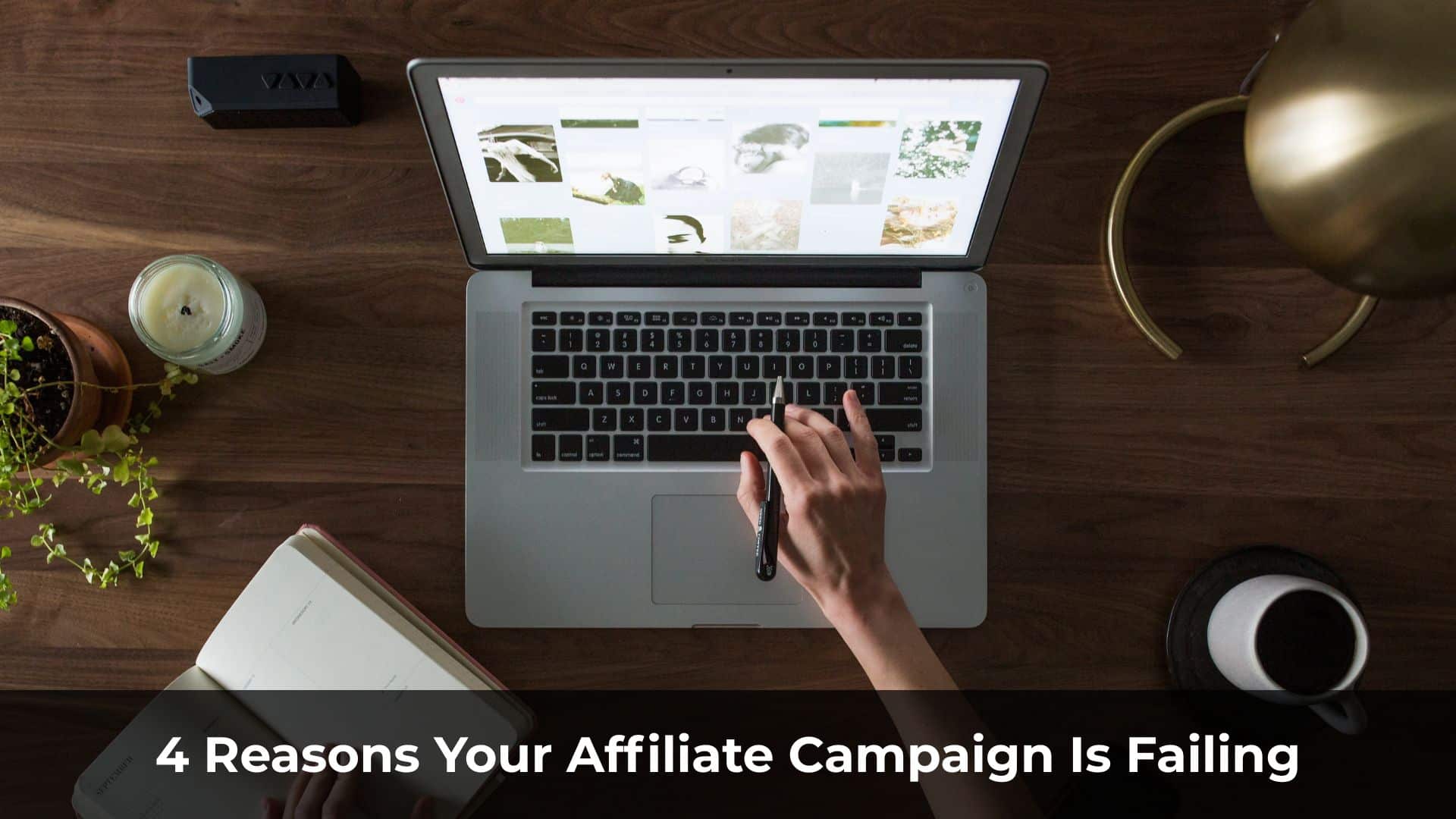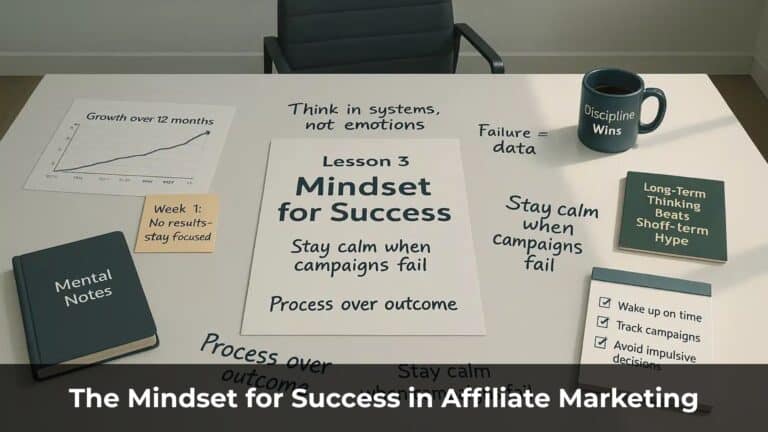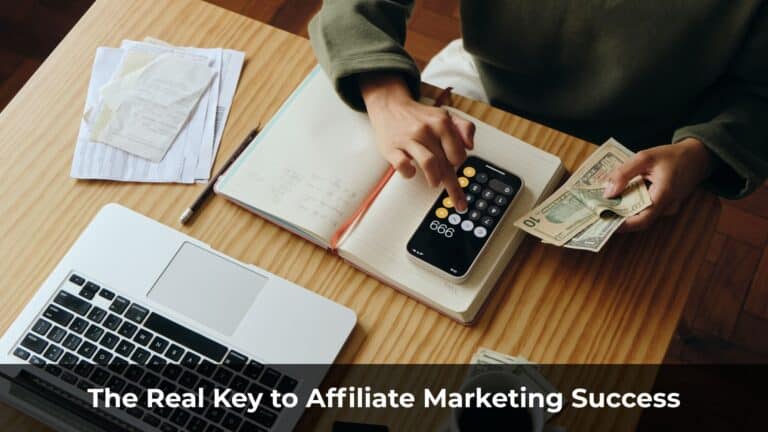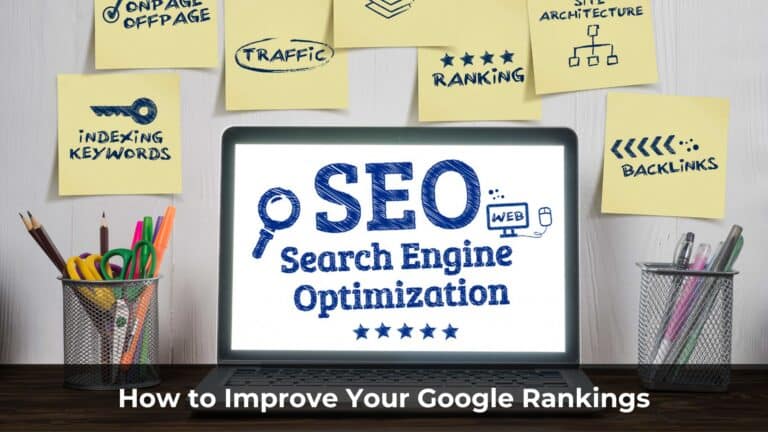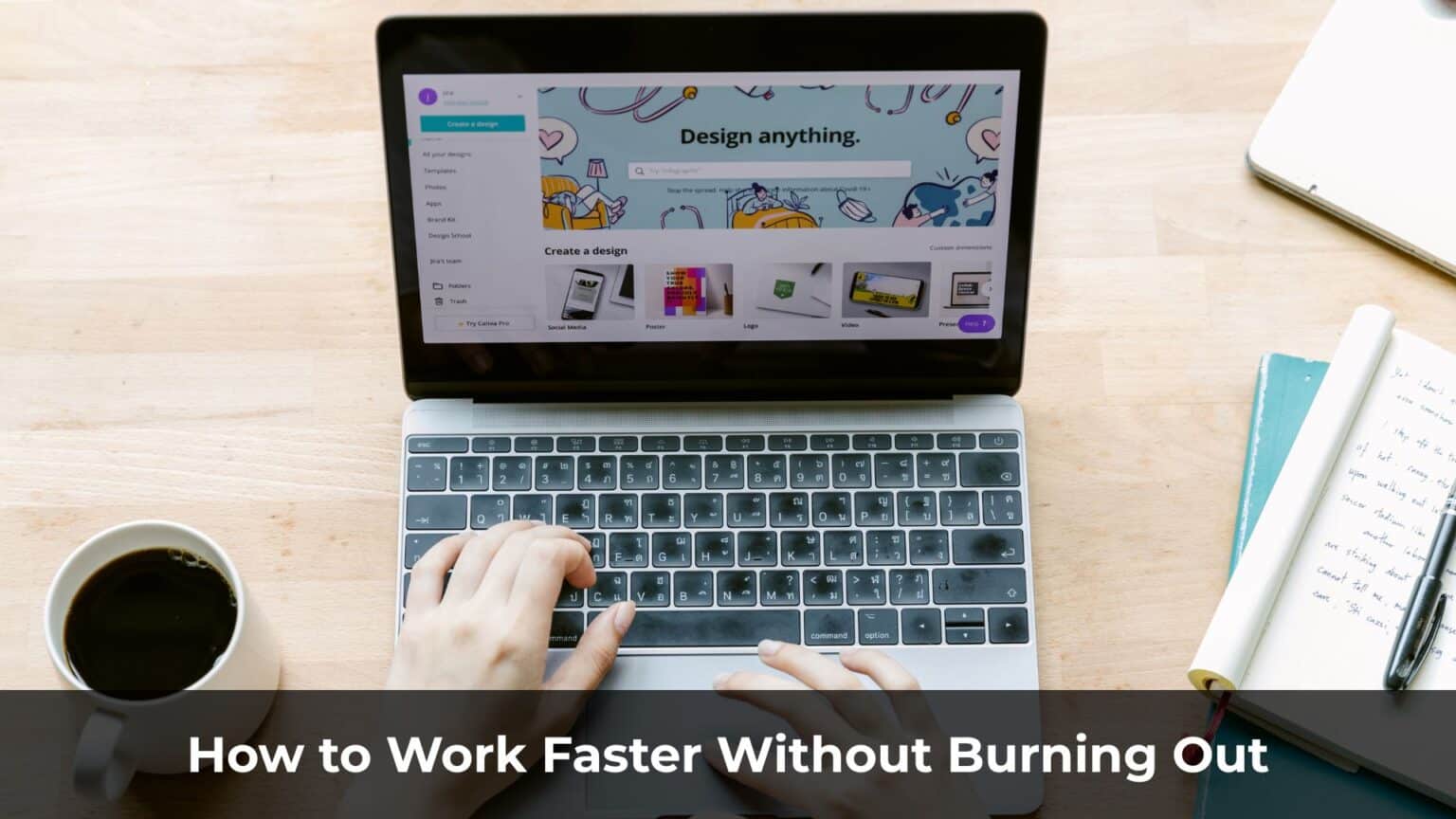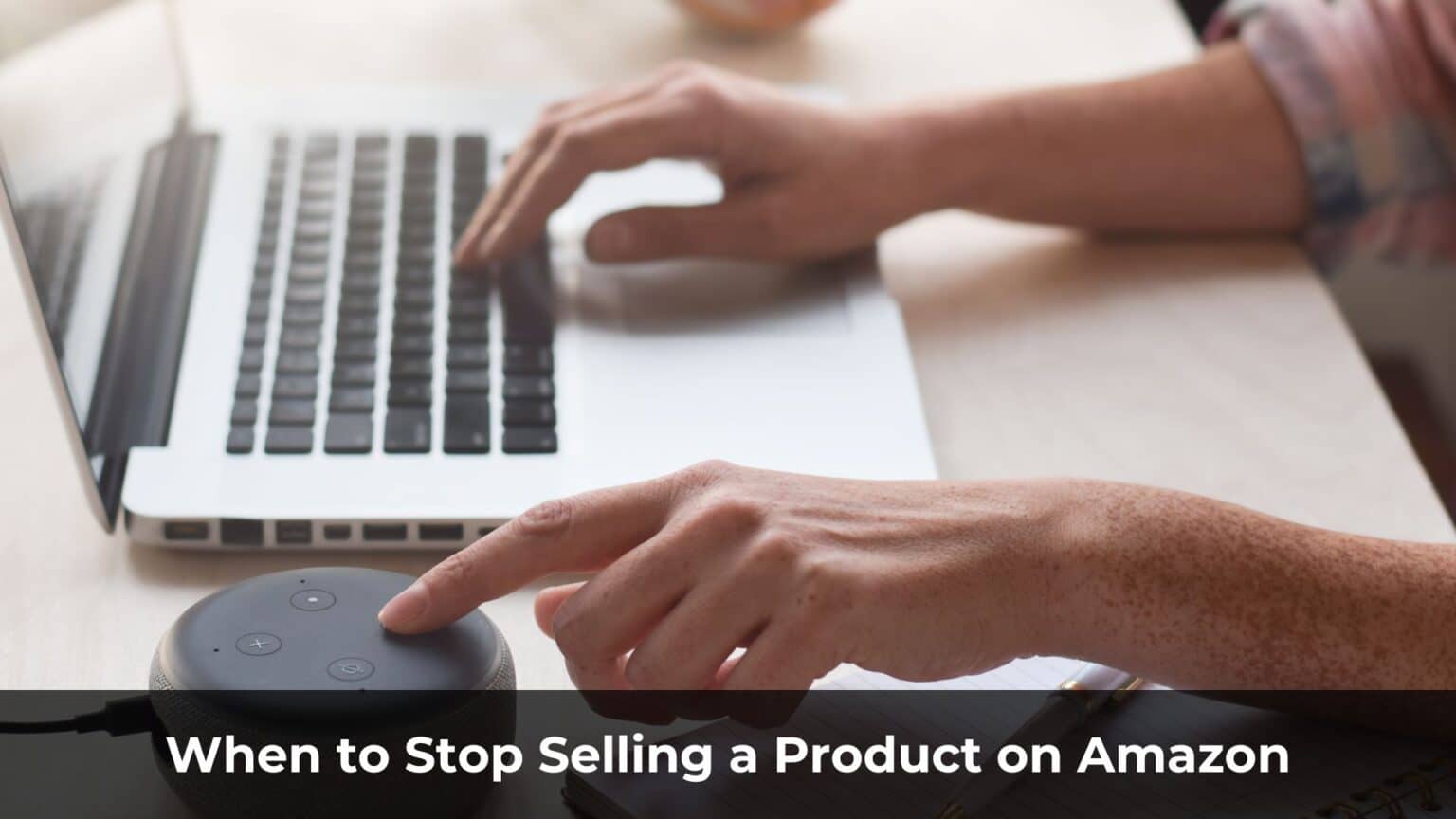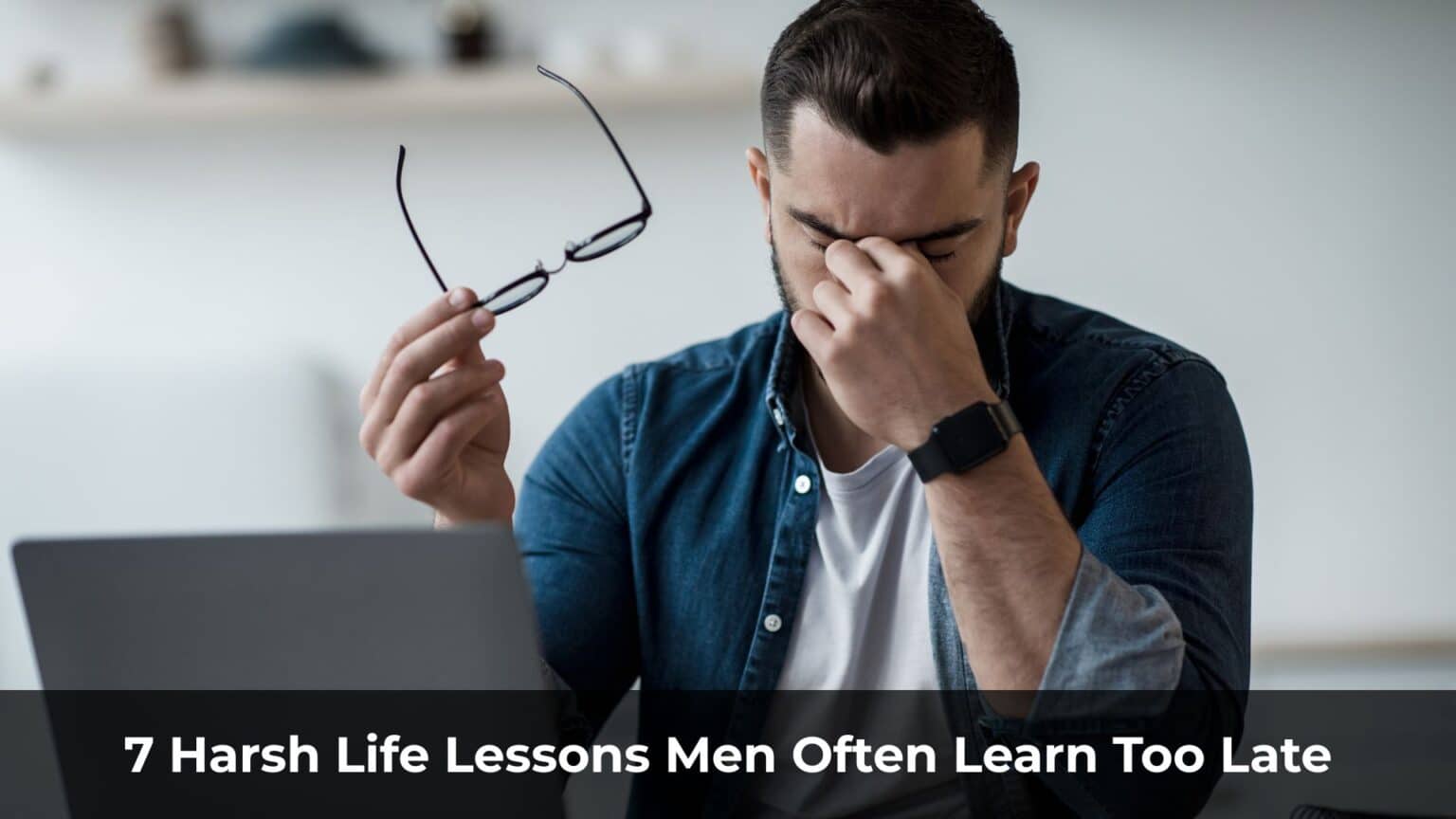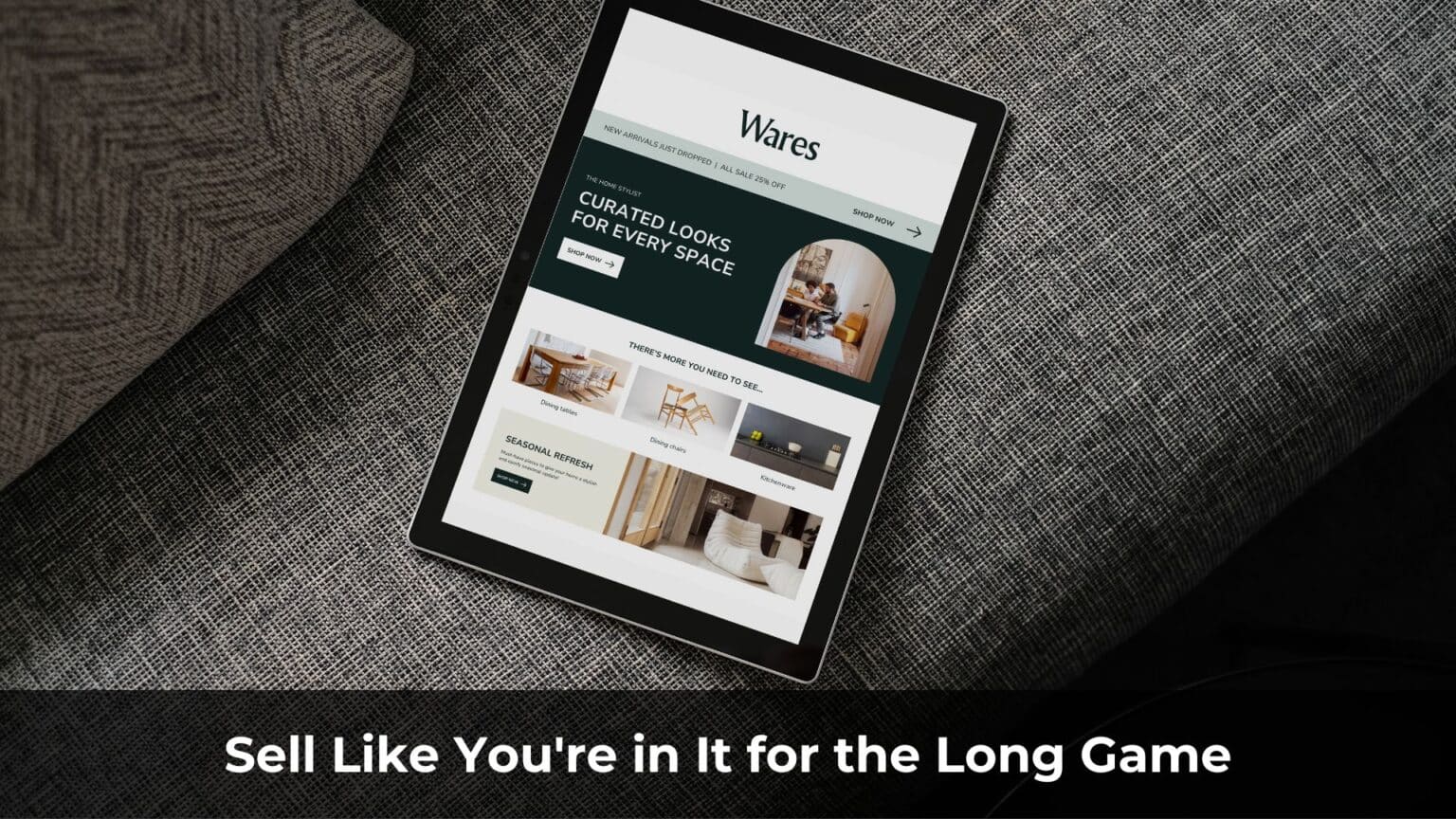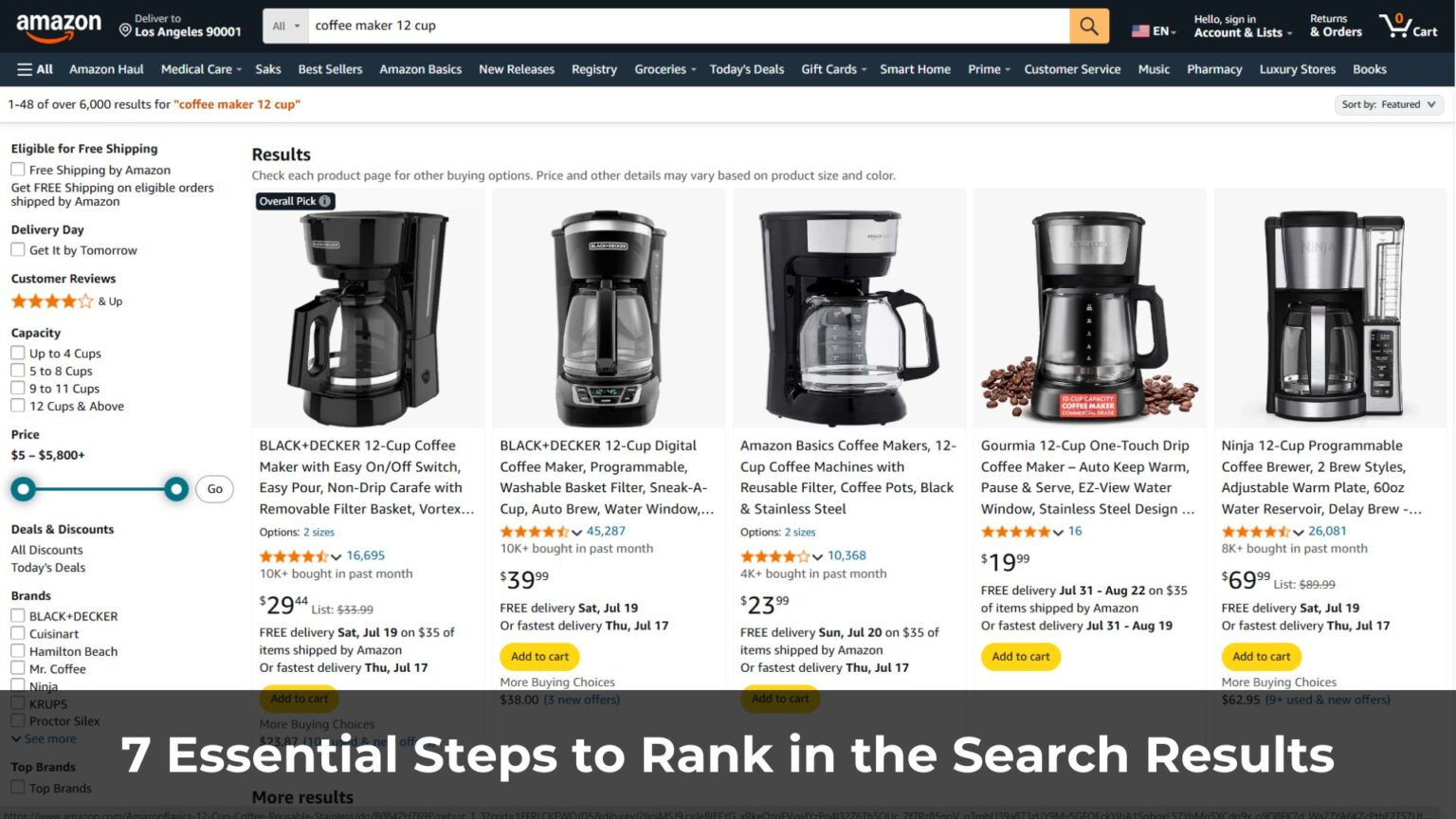Everyone loves the idea of “passive income” — launch an ad campaign, then sit back while it brings in money day after day.
Sounds great, right?
But that’s not how it really works.
Just because a campaign is profitable doesn’t mean you can set it and forget it.
In reality, you’ll need to monitor it, optimize it, and troubleshoot constantly. Running an affiliate campaign is more like raising a child — ignore it for too long, and it starts falling apart.
Campaigns don’t crash overnight.
They fade slowly.
It’s like swimming out to sea. If you’re not actively paddling back, the current will quietly drag you farther and farther — until one day, it’s too late to return.
Every affiliate has been through this. Even the top earners.
The difference?
Experienced marketers can spot the early warning signs — and more importantly, they know how to keep campaigns alive longer.
And the gap between a campaign that runs for 5 days vs. 5 weeks? Massive.
A well-maintained 5-week campaign can pay for a brand-new car.
But only if you know how to keep it from dying early.
In this post, I’ll break down the 4 most common reasons why affiliate campaigns gradually lose profit — and walk you through clear, actionable solutions for each one.
Table of Contents
ToggleReason #1: Competitors Jump In
Once your campaign starts making money, it’s only a matter of time before others try to copy it.
That’s just the nature of affiliate marketing — competition is inevitable.
Why does this happen?
A. Your offer hits the top rankings
When an offer performs well, it climbs to the top of the affiliate network’s leaderboard.
Affiliate managers often blast out emails saying,
“This offer is converting well — give it a try.”
Soon, dozens (if not hundreds) of affiliates start promoting the same thing. And suddenly, you’re not alone anymore.

B. Your ad gets exposed on spy tools
If you’ve ever used Adplexity or similar spy tools, you already know how this works.
Spy tools let competitors see your entire setup:
- Your ad creatives
- Your landing pages
- The offer you’re promoting
- Even your traffic source (especially on Native ads)
And if your competitor has a bigger budget, they can simply outbid you — grabbing better placements and pushing you out of the game.
Now you’re stuck in a bidding war you never asked for.
And without a clear strategy, you start losing premium placements, your best traffic dries up…
And the campaign slowly begins to decline.
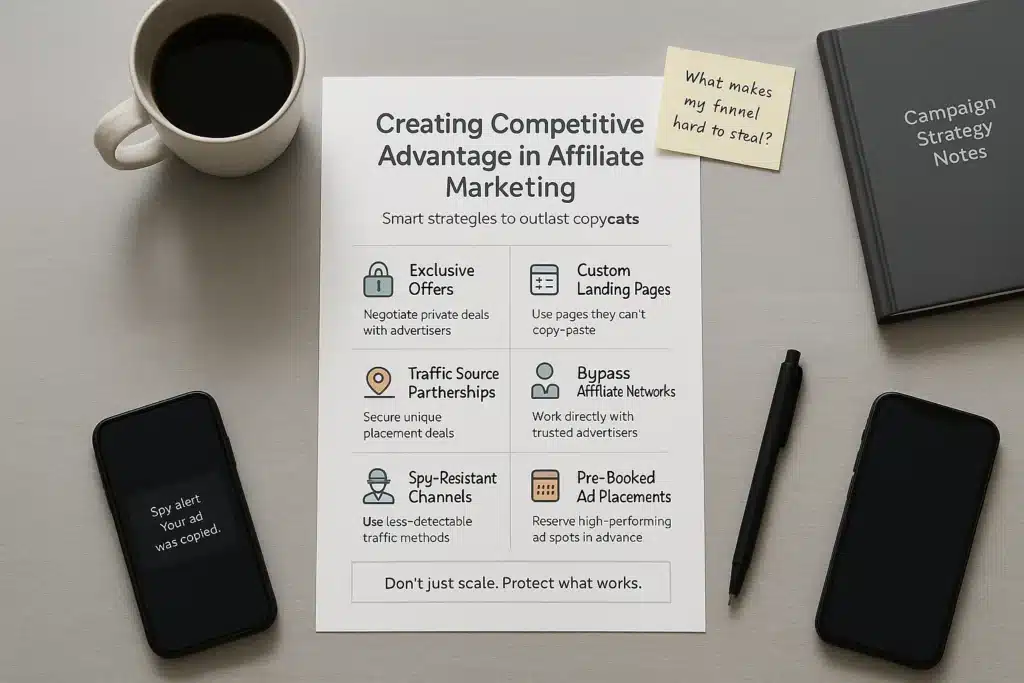
Solution #1: Build a Competitive Advantage That Others Can’t Copy
Ask yourself this:
If someone cloned your entire campaign — ad, landing page, angle, everything — what would still give you the upper hand?
The simplest answer: exclusive access.
Even if they copy your funnel pixel for pixel, they can’t run the exact same offer — if you’ve secured an exclusive deal with the advertiser.
And if they’re forced to run a similar (but different) offer? Their conversion rate probably won’t match yours.
Here are a few ways to build an advantage that’s hard to duplicate:
- Ask the advertiser to create a custom landing page just for you
- Negotiate exclusive access to the traffic source
- Use traffic channels that spy tools can’t easily track
- Work directly with advertisers, cutting out the affiliate network
- Pre-book premium ad placements before competitors can grab them
One thing I’ve learned over the years:
Campaigns last longer when you work directly with advertisers.
Why?
Because affiliate networks are designed to push volume — they want as many affiliates as possible promoting the same offer to maximize revenue.
That means more competition for you.
On the other hand, direct advertisers often handpick a few trusted partners — and keep the offer under the radar.
With less exposure comes less competition — and more breathing room for you to scale.

Solution #2: Use a Smart Strategy to Win the Bidding War
Bidding wars are part of the game — especially on open traffic sources like native ads or display networks.
But here’s the rule:
Don’t fight blindly.
If you want to survive (and win) in the bidding battlefield, you need a strategy — not just a bigger budget.
You have two main options:
a. Negotiate with the traffic source to secure better placements
With some ad platforms (especially native networks), you can reach out directly to your account manager and negotiate for:
- Priority access to premium placements
- Whitelisting on top-performing sites
- Private deals to lower your inventory cost
Don’t hesitate to build relationships.
Most traffic sources have dedicated teams for affiliates who spend consistently — and they’re often willing to support you if you’re serious.
b. Bid higher — but with clear limits
If you choose to outbid your competitors, you must know your numbers cold.
What’s your maximum CPC while still staying profitable?
Let’s say:
- Your EPC (Earnings Per Click) = $0.30
- You want to maintain at least a 30% ROI
Then your maximum CPC = $0.23
Go above that, and you’re burning money.
Your biggest advantage?
You started before your competitors.
That means you already have real data — CTR, CR, ROI — to make smarter decisions.
Use that edge. Don’t waste it.
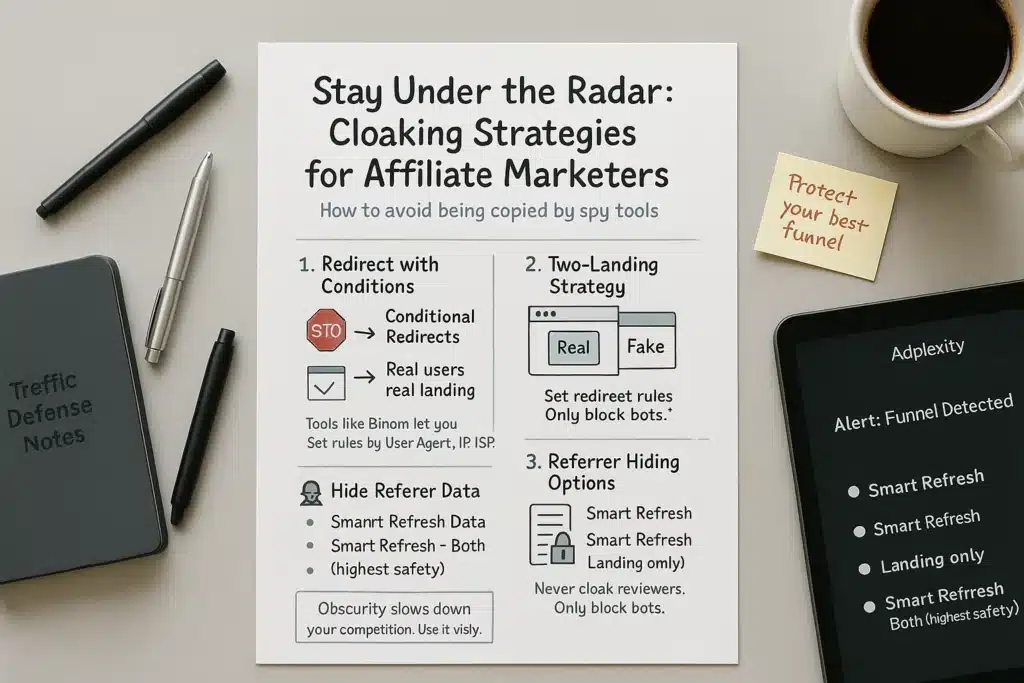
Solution #3: Don’t Be Too Visible on Spy Tools
In today’s hyper-competitive landscape, it’s almost impossible to keep your campaign hidden from spy tools like Adplexity, Anstrex, or BigSpy.
But you can still make it harder for others to copy you.
One of the best methods?
Hide your real landing page.
Let spy tools see your ad creatives or a fake pre-lander — but block them from accessing your actual conversion page.
Here’s the basic idea:
- Accept that your ads will be seen
- But use conditional redirects so only real users (human traffic) get to your main landing page
- Bots and scrapers? Send them to a decoy or irrelevant page
Some common techniques:
Use cloaking in your tracker (e.g., Binom):
Create 2 landing pages:
- One real page (designed to convert)
- One fake page (for bots)
In Binom, set up traffic rules based on:
- User Agent: filter out known bots
- IP / ISP: block IP ranges from Amazon AWS, data centers, etc.
Apply redirect rules:
- If bot → send to fake landing
- If real user → send to main landing

Important: Use cloaking only to block spy tools —
Don’t block traffic reviewers or moderation bots on platforms like Facebook Ads, or you risk getting your ad account banned.
Hide your traffic source using Binom’s “Referrer Hiding” feature
Binom lets you choose from 3 smart redirect methods:
- Smart Meta Refresh (Offer):
Hides the referrer only from landing → offer.
Good if you want to hide your traffic source from the advertiser — but still keep full tracking data. - Smart Meta Refresh (Landing):
Hides the referrer from traffic source → landing page.
Useful for protecting your funnel from spy tools monitoring your original ad. - Smart Meta Refresh (Landing & Offer):
Hides referrer on both steps — traffic → landing and landing → offer.
The most secure option. Makes your funnel nearly “invisible” to both competitors and networks. - None: No protection. Uses normal 302 redirect — leaves your funnel completely exposed.

This setup won’t make you 100% invisible — but it slows your competitors down.
And when you’re running a profitable campaign, slowing them down is enough to protect your edge.
If you haven’t implemented this yet — now’s the time to start.
Reason #2: Angle Burnout — Your Ad Is Saturated
No matter how good your ad is, if people see it too many times, they’ll start ignoring it.
This is called “ad blindness.”
It happens when users get so used to seeing the same banner, headline, or angle that they simply stop paying attention.
The results?
- CTR drops
- CPC rises
- ROI takes a hit
This problem is even worse if:
- You’re targeting a small audience segment
- Your campaign has been copied by other affiliates, all using the same angle
When too many people push the same message, saturation happens fast.
So what should you do when your angle stops working?

Solution #1: Refresh Your Angles, Ads, and Landing Pages
Here’s a simple rule:
- If your CTR drops → refresh your angle.
- If your conversion rate drops → refresh your landing page.
Here are a few ways to give your creatives a fresh look:
- Rewrite the headline with a new emotional trigger (e.g., switch from pain-based to benefit-driven)
- Change the intro structure
- Use completely different imagery
- Replace the opening hook in your video ad
- Run multiple A/B tests in parallel
If you work with a team or VA, set up a regular refresh routine — for example:
- Add 2–3 new angles every week
- Update banners every Monday and Wednesday
- Rotate ad creatives on a set schedule
Don’t wait for your campaign to crash before making changes.
A steady refresh cycle keeps you one step ahead of ad fatigue and market blindness.
Pro tip: You can build a repeatable system for generating angles — check out [this guide].
Solution #2: Target a New Audience Segment
If your current angle stops converting, maybe it’s not the message — it’s the audience.
Here’s how you can shift your targeting:
- GEO: Try different countries. If you’re running U.S. traffic, test Australia, Canada, or Eastern Europe.
- Platform: If you’re running Facebook Ads, explore YouTube, TikTok, or Native Ads.
- Segment: Same product, different angle — target a new age group, gender, or interest profile.
Even without changing the ad much, showing it to a different crowd can make it feel brand new again.
Reason #3: Low-Quality Leads (for Lead Gen Offers)
This is one of those silent killers — your campaign starts declining, but you don’t see any obvious reason why.
Let’s break down the basic life cycle of a lead:
- You (the affiliate) get paid $10 per lead
- The affiliate network takes a cut
- The advertiser tries to monetize that lead on the backend
Now here’s the issue:
If the advertiser can’t make money from your leads, they’ll start questioning the source:
“This traffic isn’t quality.”
What happens next?
- You might suddenly stop getting credit for some conversions
- For example, you send 50 leads, but only get paid for 45
- The missing 5? Hard to dispute — advertisers often cite “technical issues” as justification
And if this trend continues?
The advertiser may tell the network to pause your account from running the offer entirely.
You’ll get a message from your affiliate manager like:
“Hey, please stop traffic — the advertiser flagged your leads.”
So even if your funnel looks profitable on the surface, poor lead quality can silently kill the campaign behind the scenes.
Maintaining lead quality isn’t just about maximizing profits —
It’s about protecting your right to run the offer in the first place.

Solution #1: Improve Lead Quality — Create a Win-Win-Win for Everyone
A sustainable campaign must deliver value for all three parties:
- The advertiser makes money
- The affiliate network gets stable margins
- You maintain positive ROI
To make that happen, your leads need to be genuinely high-quality. That means:
No misleading messaging
If the product isn’t free, don’t use clickbait headlines like “100% Free Giveaway.”
Mismatched expectations = fake leads. And fake leads = no conversions for the advertiser.
Target the right audience
Example:
If you’re promoting a premium dating offer, don’t run ads to 18-year-olds.
They’ll sign up just for fun — and never pay.
Target 25+ users with disposable income. Simple shift — massive difference in lead quality.
Track traffic quality by SubID
- Assign SubIDs per campaign, traffic source, or site
- Share performance reports with your advertiser — ask for feedback on which SubIDs are converting
- Then double down on what’s working
Important: Always encrypt your SubIDs.
Some networks or advertisers have in-house media buyers — and if you’re not careful, they might reverse-engineer your traffic sources.
Solution #2: Always Test Offers — And Work Across Multiple Sources
Sometimes the problem isn’t you.
Other affiliates may have already flooded the offer with poor traffic, damaging advertiser trust.
And now you’re stuck dealing with the fallout — even if your leads are solid.
Here’s how to protect yourself:
- Test multiple offers in the same vertical
- Compare the same offer across different networks
- Prioritize exclusive access when available
Remember:
Offers come and go. Just because an offer is profitable today doesn’t mean it’ll still convert — or even exist — next week.
That’s why you need a flexible system — ready to pivot when performance drops or an advertiser becomes unreliable.
Think long-term:
Traffic is the asset. The offer is just the tool.
Reason #4: Targeting Too Narrow — You’ve Exhausted the Market
Sometimes a campaign still shows a positive ROI, but profits keep shrinking. The angle is solid. The offer still converts.
So what’s the problem?
Simple:
You’ve already reached everyone who was going to convert.
Let’s say you’re running ads in the U.S. — the third most populous country in the world.
Every day, new eyeballs see your ads.
But if you’re only targeting tiny countries like Iceland, the Bahamas, or the Maldives — with populations under a million — your ads end up hitting the same people over and over.
Eventually, they know your ad by heart — and stop clicking.
Targeting smaller markets can be a great strategy for beginners — fewer competitors, less pressure.
But once you’re profitable, it’s time to expand into new territories.

Solution #1: Pause the Campaign — Then Relaunch Later
When a campaign starts losing steam, the best move sometimes isn’t to fix it — It’s to stop it.
Take a break for a few weeks (or even months), then relaunch.
I’ve had campaigns that seemed completely “dead,” but after some time off — they suddenly became profitable again.
Why?
- New users entered the market
- Old users forgot the ad
- The platform’s algorithm shifted
The key idea:
You don’t have to kill a campaign just because it’s slowing down.
Give it a break. Then come back and retest — with fresh data and renewed momentum.
Solution #2: Expand to New Traffic Sources
If you’re crushing it on Facebook Ads — great.
But don’t be afraid to branch out:
- Google Display Network (GDN)
- Native Ads
- YouTube Ads
- TikTok Ads (depending on the offer)
Each traffic source comes with different user behavior and demographics.
You don’t have to reinvent your entire angle — just tweak the format and creatives to match the platform.
Solution #3: Geo-Scale Into New Countries
If your current market feels tapped out, it might be time to go international.
Here’s how to scale your campaign into new GEOs:
- Pick similar markets:
Start with countries that share user behavior with your original audience. For example: If you’re running in the U.S., test Canada, Australia, or the UK - Duplicate your campaign:
Clone your ads, landing pages, and funnel. Adjust content as needed for local context - Translate when necessary:
For non-English markets, translate your content into the native language. Hire a translator or use AI tools for quick localization - Run small-budget tests:
Monitor CTR, CR, and CPC. If results are solid, scale gradually
Expanding into new regions helps grow your revenue without reinventing your system — Just make sure to test carefully, one step at a time.
Final Thoughts
Just because a campaign is profitable today doesn’t mean it’ll run forever.
If you stop monitoring and optimizing, it will slowly die — literally.
There are many reasons this can happen:
- New competitors enter the space and drive up ad costs
- Your angles, banners, or landing pages get stale
- The leads you send aren’t converting — so the advertiser stops paying
- Your audience is too small — and the market saturates
The key is to spot the warning signs early — and act fast.
Don’t just chase short-term wins.
Build systems. Grow a team. Track your data. Create a clear process for testing, scaling, and adapting.
If you want to go further in affiliate marketing, this is the mindset you need.
Not just running ads.
Running a strategy.
